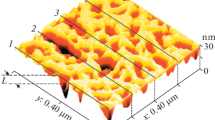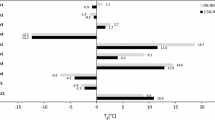Abstract
The effect of the presence of cellulose nanocrystals (CNC) and a commercial pro-oxidant additive on the production of oxidized species, crystallinity, thermal and tensile mechanical properties of low-density polyethylene (LDPE) blown films, thermally aged for 75 days at 60 °C, was studied. The oxidation products were monitored by Fourier transform infrared (FT-IR) spectroscopy, and X-ray photoelectron spectroscopy (XPS). Changes in the crystallinity were determined by X-ray diffraction (XRD), whereas the thermal properties with differential scanning calorimetry (DSC). The change in the strain at break and maximum strength of films were determined by tensile testing according to the ASTM D882 Standard Test Method. The results indicate that the thermal degradation of the LDPE films consisted of two stages: the oxidation of the polymer chains (determined by XPS, FT-IR and XRD) in the first aging stage; and the scission of the polymer chains in the advanced stage of oxidation (suggested by the drop in the strain at break of blown films). It was found that the addition of the pro-oxidant additive catalyzes the formation and decomposition of hydroperoxides and carbonyl groups during the thermal aging process; whereas the addition of CNC induces a slight thermo-oxidation during the blowing process and promotes the formation of carboxylic acid groups. Even more, the production of oxidized species induced by the CNC is comparable to that from the commercial pro-oxidant additive throughout the thermal aging. These findings suggest that CNC would be an attractive green alternative to metallic pro-oxidants to produce oxo-biodegradable polyethylene blown films.











Similar content being viewed by others
References
Sung W, Nikolov ZL (1992) Accelerated degradation studies of starch-filled polyethylene films. Ind Eng Chem Res 31:2332–2339
Weiland M, Daro A, David C (1995) Biodegradation of thermally oxidized polyethylene. Polym Degrad Stab 48:275–289
Albertsson A, Erlandsson B, Hakkarainen M (1998) Molecular weight changes and polymeric matrix changes correlated with the formation of degradation products in biodegraded polyethylene. J Environ Polym Degrad 6:187–195
Ojeda TFM, Dalmolin E, Forte MMC, Jacques RJS, Bento FM, Camargo FAO (2009) Abiotic and biotic degradation of oxo-biodegradable polyethylenes. Polym Degrad Stab 94:965–970
Roy PK, Titus S, Surekha P, Tulsi E, Deshmukh C, Rajagopal C (2008) Degradation of abiotically aged LDPE films containing pro-oxidant by bacterial consortium. Polym Degrad Stab 93:1917–1922
Chiellini E, Corti A, D’Antone S (2007) Oxo-biodegradable full carbon backbone polymers—biodegradation behaviour of thermally oxidized polyethylene in an aqueous medium. Polym Degrad Stab 92:1378–1383
Hubbe MA, Rojas OJ, Lucia LA, Sain M (2008) Cellulosic nanocomposites: a review. BioResources 3:929–980
Sanchez M, Lagaron J (2010) On the use of plant cellulose nanowhiskers to enhance the barrier properties of polylactic acid. Cellulose 17:987–1004
Fortunati E, Peltzer M, Armentano I, Torre L, Jiménez A, Kenny JM (2012) Effects of modified cellulose nanocrystals on the barrier and migration properties of PLA nano-biocomposites. Carbohydr Polym 90:948–956
Ramires EC, Dufrese A (2011) A review of cellulose nanocrystals and nanocomposites. TAPPI J 10:7–14
Azouz KB, Ramires EC, Van Den Fonteyne W, Kissi NE, Dufresne A (2012) Simple method for the melt extrusion of a cellulose nanocrystal reinforced hydrophobic polymer. ACS Macro Lett 1(236–240):2012
de Menezes AJ, Siqueira G, Curvelo AAS, Dufresne A (2009) Extrusion and characterization of functionalized cellulose whiskers reinforced polyethylene nanocomposites. Polymer 50:4552–4563
Sapkota J, Natterodt JC, Shirole A, Foster EJ, Weder C (2017) Fabrication and properties of polyethylene/cellulose nanocrystal composites. Macromol Mater Eng 302:1–6
Shafizadeh F, Bradbury AGW (1979) Thermal degradation of cellulose in air and nitrogen at low temperatures. J Appl Polym Sci 23:1431–1442
Kolar J (1997) Mechanism of autoxidative degradation of cellulose. Restaurator 18:163–176
Low Density Polyethylene PX 20020-X Product Specification. http://www.solquim.com. Accessed 07 Oct 2017
Cellulose Nanocrystals Product Specification. http://umaine.edu/pdc/files/2016/03/Specs-CNC.pdf. Accessed 07 Oct 2017
Jakubowicz I (2003) Evaluation of degradability of biodegradable polyethylene (PE). Polym Degrad Stab 80:39–43
Jakubowicz I, Yarahmadi N, Petersen H (2006) Evaluation of the rate of abiotic degradation of biodegradable polyethylene in various environments. Polym Degrad Stab 91:1556–1562
Gugumus F (1995) Re-examination of the role of hydroperoxides in polyethylene and polypropylene: chemical and physical aspects of hydroperoxides in polyethylene. Polym Degrad Stab 49:29–50
Wang W, Qu B (2003) Photo and thermo-oxidative degradation of photocrosslinked ethylene–propylene–diene terpolymer. Polym Degrad Stab 81:531–537
Munaro M, Akcelrud L (2008) Correlations between composition and crystallinity of LDPE/HDPE blends. J Polym Res 15:83–88
Erlandsson B, Karlsson S, Albertsson AC (1997) The mode of action of corn starch and a pro-oxidant system in LDPE: influence of thermo-oxidation and UV-irradiation on the molecular weight changes. Polym Degrad Stab 55:237–245
Gugumus F (2002) Re-examination of the thermal oxidation reactions of polymers 3. Various reactions in polyethylene and polypropylene. Polym Degrad Stab 77:147–155
Gugumus F (2002) Thermolysis of polyethylene hydroperoxides in the melt 5. Mechanisms and formal kinetics of product formation. Polym Degrad Stab 76:381–391
Da Cruz M, Van Schoors L, Benzarti K, Colin X (2016) Thermo-oxidative degradation of additive free polyethylene. Part I. Analysis of chemical modifications at molecular and macromolecular scales. J Appl Polym Sci 133:43287–43303
Morrison R, Boyd R (1992) Organic chemistry. Sixth edition. J Chem Educ 69(11):A305
Hoàng EM, Allen NS, Liauw CM, Fontán E, Lafuente P (2006) The thermo-oxidative degradation of metallocene polyethylenes. Part 1: long-term thermal oxidation in the solid state. Polym Degrad Stab 91:1356–1362
Sapieha S, Pupo JF, Schreiber HP (1989) Thermal degradation of cellulose containing composites during processing. J Appl Polym Sci 37:233–240
Strlič M, Kolar J, Pihlar B, Rychlý J, Matisová-Rychlá L (2000) Chemiluminescence during thermal and thermo-oxidative degradation of cellulose. Eur Polym J 36:2351–2358
Rychlý J, Matisová-Rychlá L, Lázar M, Slovák K, Strlič M, Kočar D, Kolar J (2004) Thermal oxidation of cellulose investigated by chemiluminescence. The effect of water at temperatures above 100 °C. Carbohydr Polym 58:301–309
Vickerman JC, Gilmore IS (eds) (2009) Surface analysis—the principal techniques. Wiley, Chichester, West Sussex (chapter 3)
Tireau J (2011) Propriétés à long terme des gaines de polyéthylène haute densité utilisées pour les ponts à haubans. Institut des Sciences et Technologies
Khabbaz F, Albertsson AC, Karlsson S (1999) Chemical and morphological changes of environmentally degradable polyethylene films exposed to thermo-oxidation. Poym Degrad Stab 63:127–138
Roy PK, Surekha P, Raman R, Rajagopal C (2009) Investigating the role of metal oxidation state on the degradation behaviour of LDPE. Polym Degrad Stab 94:1033–1039
Khabbaz F, Albertsson AC (2001) Rapid test methods for analyzing degradable polyolefins with a pro-oxidant system. J Appl Polym Sci 79:2309–2316
Gulmine JV, Janissek PR, Heise HM, Akcelrud L (2003) Degradation profile of polyethylene after artificial accelerated weathering. Polym Degrad Stab 79:385–397
Hakkarainen M, Albertsson AC (2004) Environmental degradation of polyethylene. Adv Polym Sci 169:177–199
Acknowledgements
The analyses by X-ray diffraction and X-ray photoelectron spectroscopy were carried out in the Laboratorio Nacional de Nano y Biomateriales (Financed by Fomix-Yucatán y Conacyt), Cinvestav-IPN. Unidad Mérida. The authors thank PhD. Patricia Quintana for the access to the LANNBIO, M.C. Daniel Aguilar Treviño and Eng. Wilian Cauich for their technical support in the XRD and XPS analyses, respectively. The technical assistance of PhD. Wilberth Antonio Herrera Kao in the FT-IR and DSC analysis is acknowledged. This study was partially financed by the project FOMIX-Yucatan CICY YUC-2014-C17-247046.
Author information
Authors and Affiliations
Corresponding author
Rights and permissions
About this article
Cite this article
Moo-Tun, N.M., Valadez-González, A. & Uribe-Calderon, J.A. Thermo-oxidative aging of low density polyethylene blown films in presence of cellulose nanocrystals and a pro-oxidant additive. Polym. Bull. 75, 3149–3169 (2018). https://doi.org/10.1007/s00289-017-2204-y
Received:
Revised:
Accepted:
Published:
Issue Date:
DOI: https://doi.org/10.1007/s00289-017-2204-y




